Death from above – war of drones in Ukraine
The war in Ukraine is called the first total drone war. The same drones that can be bought in stores are used more actively on the battlefield. Drones have long been used in war, but never as widely as in Ukraine, by both warring sides. Correspondent Morgunblaðinn recently managed to observe the work of a military unit that specializes in espionage using drones and interception of electronic communications.
Both countries use both attack drones and spy drones. Attack drones drop bombs or are bombs themselves and are destroyed when attacked, like Iran’s Sahed 136, which is often used by Russia. Spy drones are used to survey the position and location of enemy forces, and to send information to artillery, aviation and strike drones to make attacks more precise.
In addition to drones, the war in Ukraine is characterized by trench warfare and artillery, reminiscent of the First World War, where the battle line remains static. A war of attrition is now more characteristic than a war of maneuver, where territory changes hands quickly, as in Russia’s advance in the south at the start of the war and in Ukraine’s blitzkrieg in Kharkiv Oblast this fall.
The recent drone attacks on Moscow further demonstrate the importance of drones in the war in Ukraine (most likely they were Ukrainian-made UJ-22 drones with a range of 800 km). The Ukrainians do not have missiles that can be directed at targets in Russia, but there are frequent drone attacks on targets on the territory of Russia, both in Crimea and in the south of Russia. Ukraine’s goals are to bring the war to Russia both for military purposes and to demonstrate to Russian society that this is a war and not a “selective military operation” on the territory of Ukraine. Ukrainians hope to influence public opinion in this country by attacking Russia.
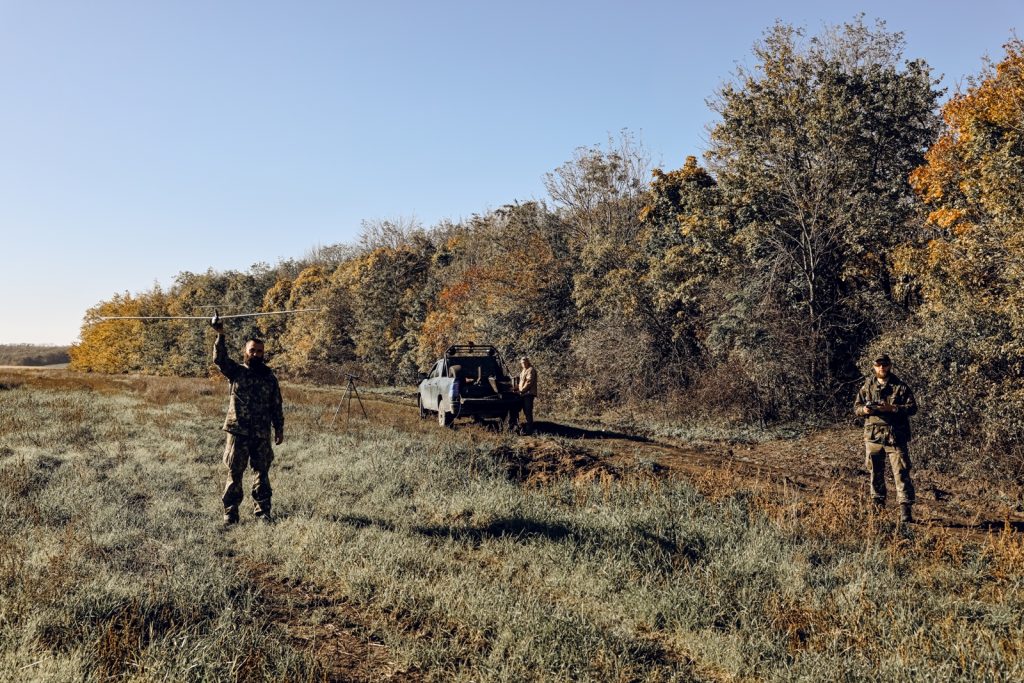
The Ukrainian military is preparing to launch drones. Both have to throw it into the air, but at the same time one has to control it with a remote control. Photo/Oksana Johannesson
Fighting at a distance
Drone warfare gives this war a new dimension. It is fought from a distance like an artillery war, and drones play a key role in targeting the artillery. Soldiers rarely fight face to face. Thousands of drones fly over the battlefield in Ukraine every day. In previous conflicts, such as in Afghanistan and Iraq, drones were used by one of the warring parties, the United States, in uncontested airspace. Ukraine is fighting for air supremacy, and both warring parties have modern anti-aircraft weapons.
The fight against drones is another angle of this conflict. Drones are shot down by flak weapons, smaller drones are sometimes shot down by rifles and sniper rifles. Electronic warfare equipment can also be used to disrupt and disrupt remote control and video transmissions of drones. Both warring parties use their own technologies, which explains, among other things, why the lifespan of smaller drones is short, averaging only four flights. According to estimates, Ukrainians lose up to 10,000 drones a month on the 1,200 km long front line. Most of these drones are destroyed by electronic weapons.
Other countries are showing great interest in this drone war. This is a test of how interstate wars may develop in the future, a tame war between China and Taiwan.
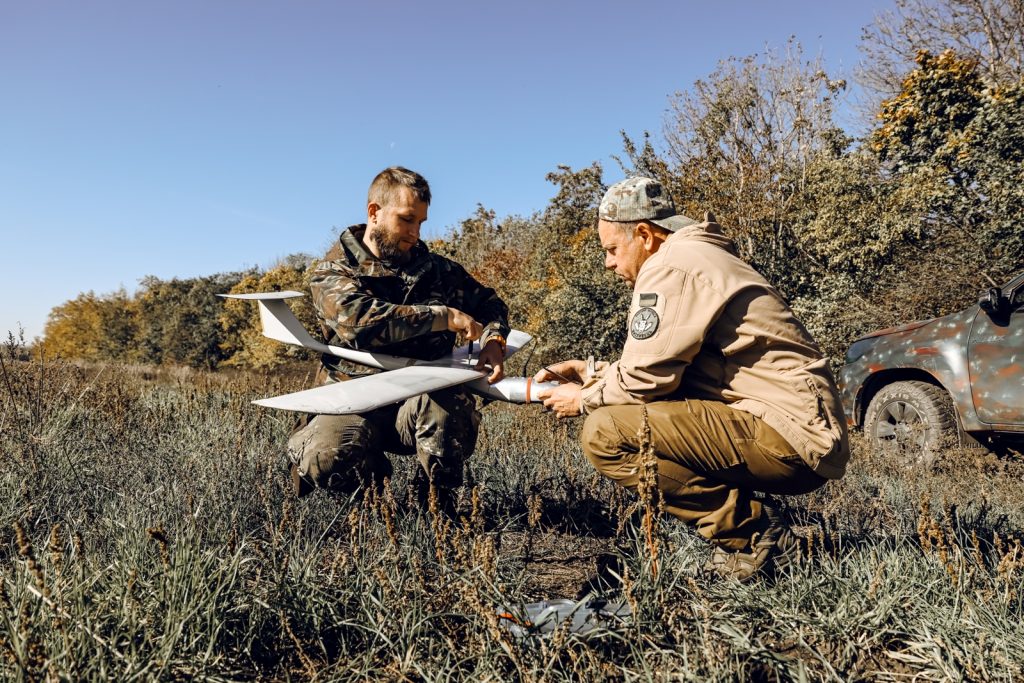
Ukrainian military assembles a drone in a field. Photo/Oksana Johannesson
The main drones of Ukraine:
Switchblade 300: US strike drone. Weight: 2.5 kg. Length: 50 cm. Range: 10 km. Maximum speed: 160 km. Designed to destroy small groups of soldiers and armored vehicles.
Bayraktar TB2: Turkish spy and attack drone. About the size of a colored airplane. Weight: 550 kg. Length: 6.5 m. Range: 300 km. Maximum speed: 220 km. Equipped with high-precision bombs with laser guidance. Its size makes it vulnerable to anti-aircraft missiles.
DJI Matrice 300 RKT: Chinese spy drone that you can buy in stores. Weight: 3.5 kg. Length: 80 cm. Range: 15 km. Maximum speed: 80 km. Inexpensive drones like the Matrice have greatly improved frontline visibility. They can carry bombs the size of grenades.
The main drones of Russia:
Orlan-10: the workhorse of the Russian army. A winged spy drone with electronic warfare capabilities (to disrupt enemy drones). Weight: 5 kg. Length: 2 m. Range: 110 km. The maximum speed is 150 km. The drone is equipped with a gasoline engine and is therefore noisy.
Shahed-136 (Heran-2 in Russian): Iranian attack drone (self-destruct). Triangular. Weight: 200 kg. Length: 3.5 m. Range: 2400 km. The maximum speed is 185 km. The strategy includes a 50-kilogram bomb that can destroy an entire building. A loud motor drives the drone. Shooting down such a drone with anti-aircraft missiles is expensive, because it is about 10 times cheaper than anti-aircraft missiles.
Drones used by both Ukraine and Russia:
DJI Mavic 3: A small Chinese spy drone that you can buy in stores. Weight: 1 kg. Length: 35 cm. Range: 15 km. Maximum speed: 70 km. This is the most common drone in the arsenals of Ukraine and Russia. Hundreds fly on the battlefield every day and can carry small bombs. During the Ukrainian blitzkrieg in the Kharkiv region, these drones were used to drop bombs on minefields to clear the way for troops. However, their primary purpose is to locate enemy weapons and manpower in order to direct and adjust artillery attacks.
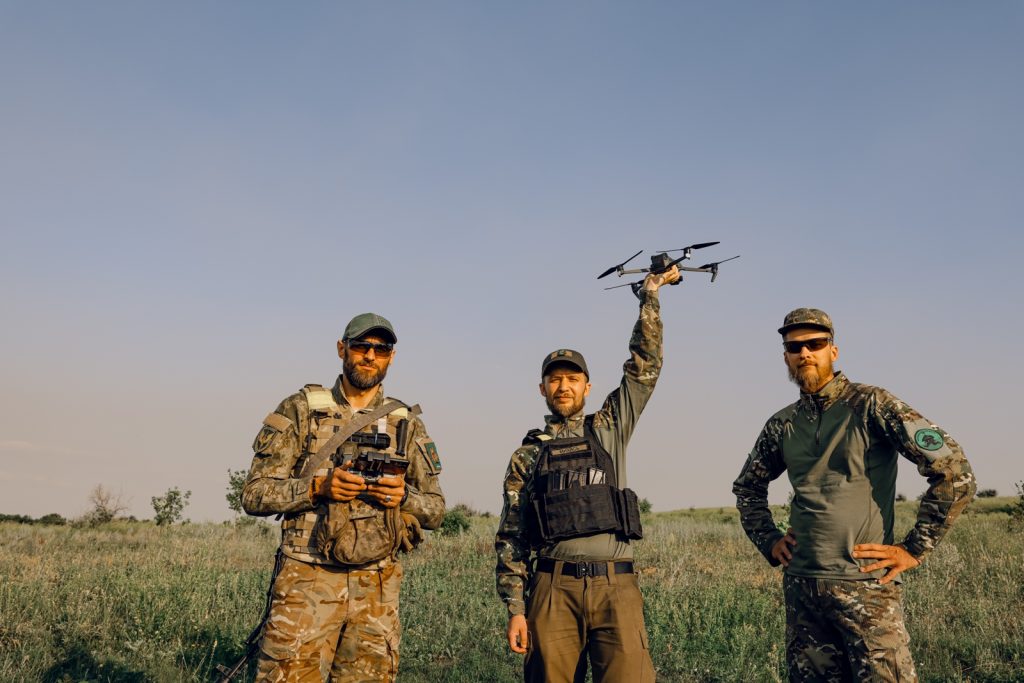
Ukrainian military with a small drone that can be bought in stores. Photo/Oksana Johannesson
Kulchytsk army
To learn more about drone warfare, we visited a military unit in the city of Sviatohirsk (Holy Mountain) that specializes in drone espionage and interception of Russian military communications, ie. aerial reconnaissance and audio reconnaissance. By coordinating these two elements, you can get a clearer picture not only of military equipment and locations, but also of the enemy’s intentions and plans. We listen to recordings of Russian military communications – on one, a soldier tries to bite a night sight and a stolen silver horse. On the other hand, soldiers complain of poor equipment and limited supplies.
The force consists of volunteers, many of whom have experience in the field of information technology. The brigade was originally part of the Kulchytsky volunteer brigade (named after the brigade’s founder), which has been participating in hostilities in Donbas since 2014. In the first months of the war in 2022, many fighters of the brigade volunteered again, and spets. a unit was created that specialized only in air and sound reconnaissance. The unit was named Tcherkes.
Cherkes participated in the liberation of Kyiv region last March, where air and sound reconnaissance played a key role in the battles with the Russian army.
The conflict around Sviatohirsk
Sviatohirsk is a city of 4,000 people on the banks of the Siverskyi Donets River, which was liberated in September after more than 3 months of Russian occupation. Sviatohirsk is a resort town and has an ancient monastery, which is partially built into the mountain. The 28-meter Constructivist statue of Soviet revolutionary Artem stands above the city, the largest Constructivist statue in the former Soviet Union.
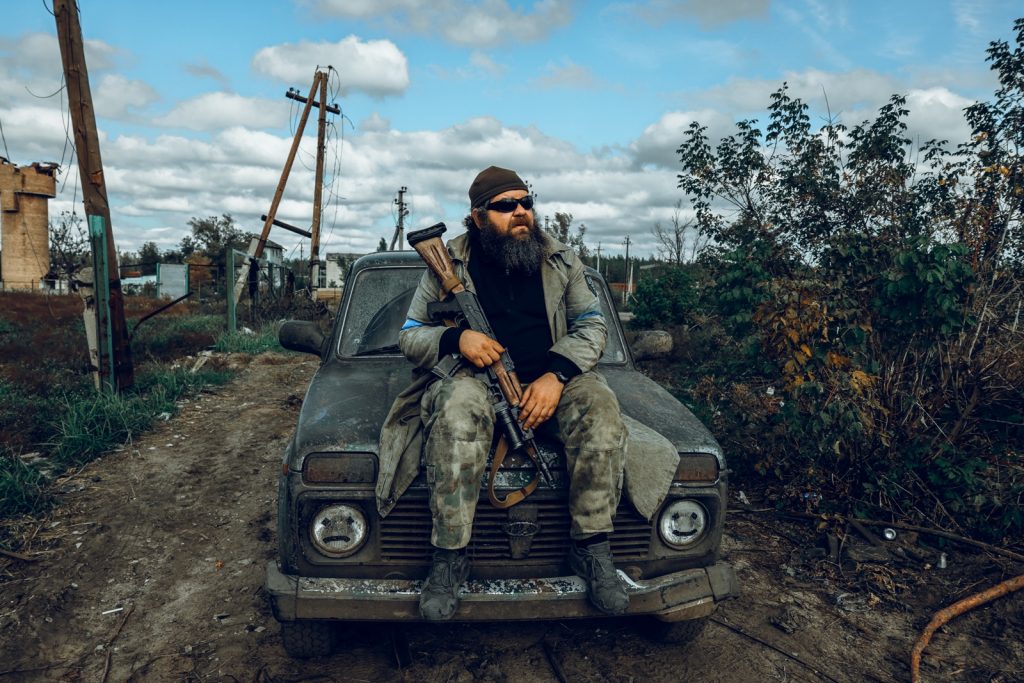
“Baton”, commander of the battalion’s air reconnaissance department. Photo/Oksana Johannesson
Our guide is called Baton. He is the head of the Air Intelligence Department. There is a lot of destruction in the city, in many places there are piles of rubble and destroyed military equipment of the Russian army. Used ammunition of the Russian army is scattered near the church in the center of the city. Baton says that his brigade and the Ukrainian army retreated from the city in early June, mainly due to a lack of artillery support. During the blitzkrieg of the Ukrainian army in September, they regained control over the city, but during the retreat, the Russians blew up the bridge connecting the city with the monastery. Baton’s reconnaissance unit played a key role in the liberation of the city. With the help of drones, they provided detailed information about the location of Russian troops and military equipment.
The mission of the air reconnaissance department
We stayed with the army in the basement of the building to familiarize ourselves with the daily routine and learn more about the work of the army. It’s safer to be in the basement than upstairs in case the Russians bomb. There is plenty of food, as in all the regiments we visited. Judging by the interceptions of Russian communications, they often complain about the lack of food.
The next day, we go with a soldier named Haydamaka to the blown-up bridge to the monastery. He says that the air reconnaissance unit works around the clock. She receives tasks from the coordination center of the Ukrainian army regarding which areas should be controlled, drones are launched into the air and coordinates are returned. The coordination center transmits the coordinates of the artillery that is firing. With the help of drones, they evaluate the results and, if necessary, adjust the coordinates. “It’s a war of artillery and drones,” says Haydamak.
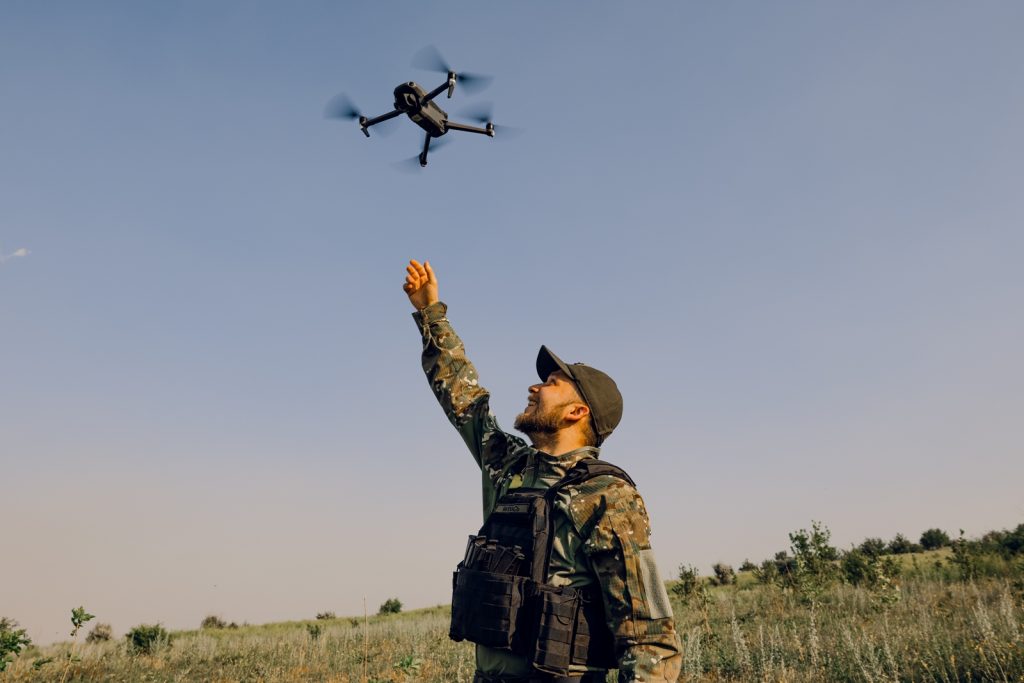
A small spy drone was launched. Every month, Ukrainians lose about 10,000 drones, mostly due to Russian electronic weapons. Photo/Oksana Johannesson
A soldier named Joker joins us. We go with him and another soldier to a field nearby. The Joker says he was wounded there months ago during an artillery barrage when the Russians managed to locate the drone’s crew. This is a risk that all drone soldiers must take.
The drone is launched
The military is about to launch a Ukrainian drone. It weighs 10 kg and can fly a distance of 20 km in one hour. He has a Russian Orlan-10 that runs on batteries and flies quietly. The drone fits into a long handbag. First, it needs to be assembled, which takes quite a lot of time. Then one soldier must run with it and throw it away. This saves additional equipment and simplifies transportation. Another soldier controls the drone by remote control, while a third watches what is happening on the computer screen and gives instructions to the operator. We ask Joker what is the most difficult thing about piloting a drone. He says that he stays calm during the flight. There are many things that can go wrong. The main thing is not to lose control of the drone, especially if you start shooting at it or if electronic weapons are used. Then you have to turn it back so it doesn’t get lost. According to him, Ukraine is currently the best country for training in flying military drones, as piloting them on the battlefield requires special skills.
Technology is not enough
Drone soldiers say that the Ukrainian military uses drones more effectively than the Russian ones. The decision-making process is simpler, lower-ranking officers have more decision-making power and can therefore make decisions about artillery fire much more quickly. This is in line with NATO military standards, according to which lower-ranking officers are given more freedom and are encouraged to take the initiative. In Russia, authorization for attacks often has to come from senior officers, which delays decision-making. The target was often moving when the decision to attack finally came. Russian military standards are still firmly rooted in the Soviet way of thinking. This mindset is also reflected in the indifference to civilian casualties, as seen in the massive and inaccurate artillery shelling of Ukrainian cities such as Mariupol, Severodonetsk and Bakhmut. The Soviet mindset is also reflected in indifference to losses within its own ranks, such as repeated frontal attacks over months on the towns of Soledar and Bakhmut, which resulted in huge casualties and limited results, although the Russians eventually captured both Soledars. and Bakhmut has his strength after great losses.
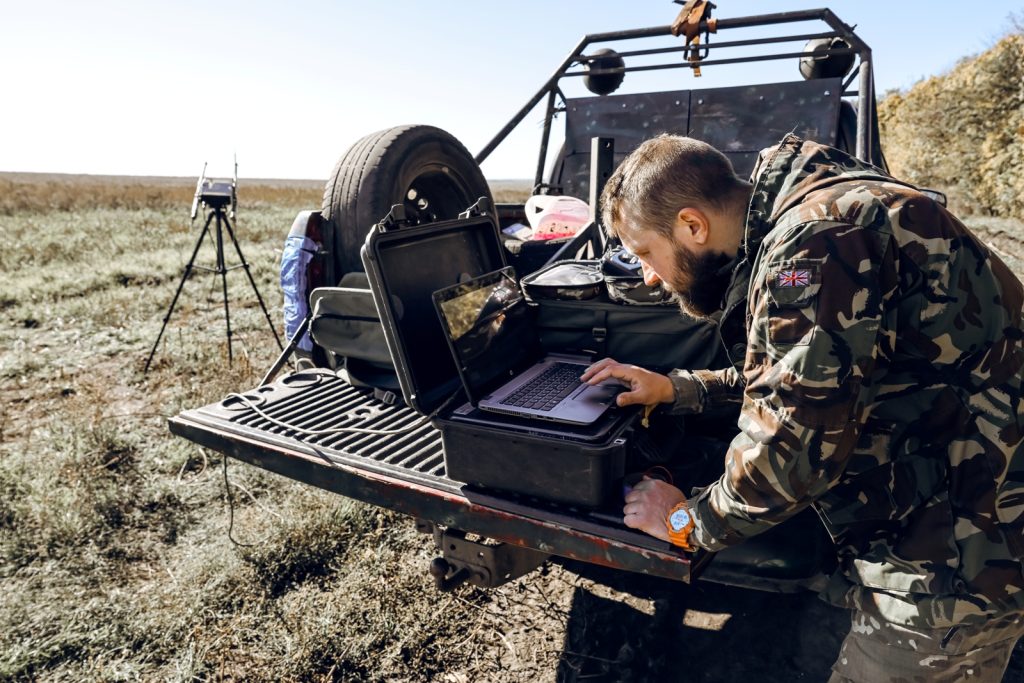
A Ukrainian military man adjusts the drone through a laptop. Photo/Oksana Johannesson
The evolution of drone warfare
Every day, thousands of drones fly over Ukraine, which are the main part of almost every military operation. The enemy is often many kilometers away, but drones give Ukraine and Russia the ability to see and attack from a distance, usually with artillery weapons, but sometimes with attack drones, helicopters and aircraft. The country that performs better in this drone war will have a better chance of winning.
Currently, Russia is experiencing a shortage of Orlan-10 drones. Many components, such as semiconductors, are now harder to obtain than before due to economic constraints, and Russia is now completely dependent on Iran for attack drones.
How the drone war will develop in the coming months, or even years, is hard to say.
In addition to long-range attack drones and reconnaissance drones, the Ukrainians need a large number of low-cost reconnaissance drones to support artillery operations on the battlefield, such as the DJI Mavic.
Ukrainian officials said that this year they plan to buy 200,000 drones, both Ukrainian and foreign, but now about 30 companies produce drones in Ukraine. The goal is to be able to control the entire battle line in real time. A powerful base model is also required to process all the information received from the drones.
The war in Ukraine showed that drones have now become as important a part of the armed forces as tanks, infantry, artillery, air defense, air force and navy
It is safe to say that drones are the future in Ukraine.
The author of the article and a photographer with an army of drones.
Primary source: https://www.mbl.is/frettir/erlent/2023/06/20/daudi_ad_ofan_dronastridid_i_ukrainu/